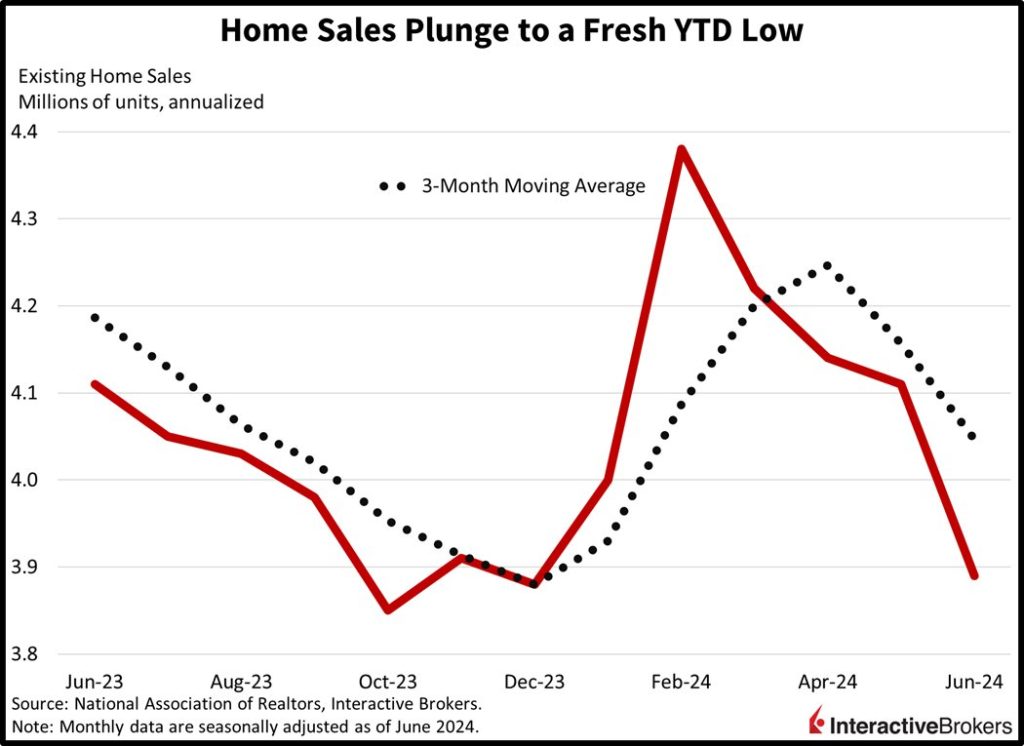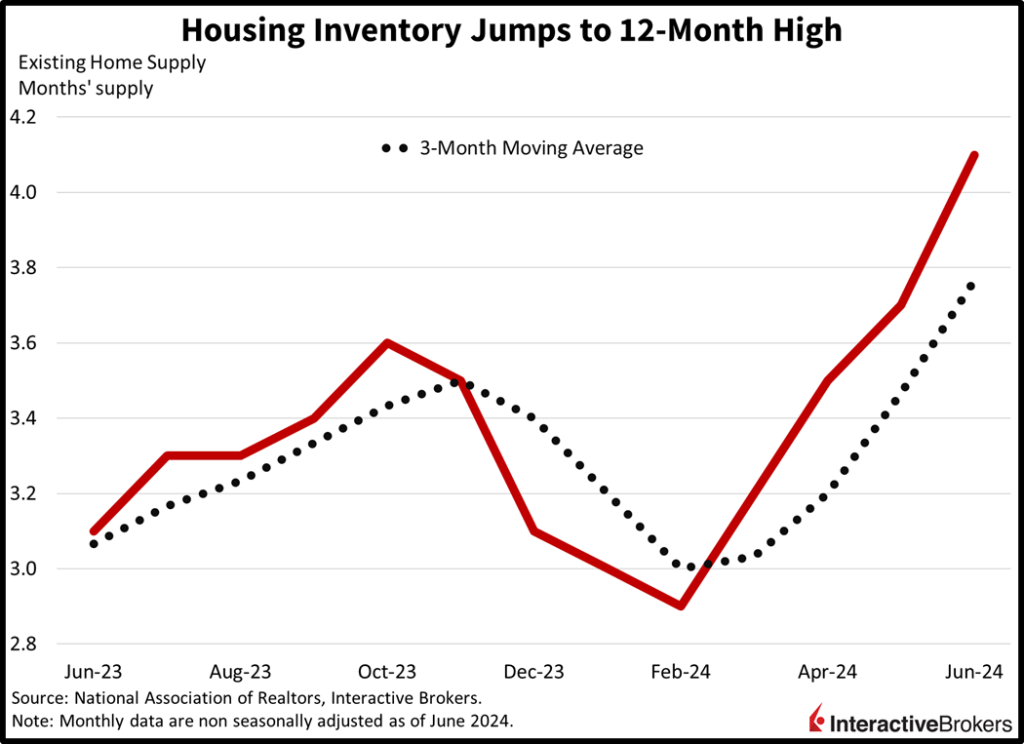By: Jose Torres, Interactive Brokers’ Senior Economist
Yesterday it was the Harris Trade but today it’s the Trump trade as stocks attempt to bounce back from last week’s selloff by using any lever they can pull. But from a probability perspective, election odds haven’t changed much, with Trump still expected to handily become 47. The latest bout of optimism among democrats appears to be stemming from a burst of fresh air resulting from Kamala Harris heading the party’s presidential ticket. Still, it’s highly unlikely that she can claim victory in key battleground states that President Biden captured with his manufacturing heavy, working-class, Scranton background. Harris, in contrast, is a California native and is presumably much more comfortable in Silicon Valley than in the Rust Belt, her former running mate’s stronghold. Against the backdrop, corporate earnings depict a cautious consumer while the economic calendar offers no light at the end of the tunnel for struggling realtors.
Home Sales Slip as Inventory Climbs
Supply conditions improved significantly in the residential real estate sector last month as sellers grew impatient, but the one-two punch of all-time high prices and elevated mortgage rates overwhelmed the positive effects of loftier inventory. Indeed, the pace of existing home transactions plunged further south to levels that were among the lowest since the great financial crisis. June existing home sales slipped to 3.89 million seasonally adjusted annualized units, a 5.4% month-over-month (m/m) decline, even as inventory rose 3.1% m/m to 1.32 million. Furthermore, inventory as measured by the ratio of the months’ supply and the rate of current monthly sales levitated from 3.7 to 4.1 m/m and from 3.1 months during the same period a year ago.
Despite all four regions posting weakness, the median home sale price rose to $426,900, the tallest level ever recorded. Additionally, condominium and cooperative sales weighed on the headline, with the segment’s 7.1% m/m decline in the pace of transactions underperforming the single-family component’s 5.1% drop. Across the nation, the pace of sales sunk in the Midwest, South, West and Northeast by 8%, 5.9%, 2.6% and 2.1% m/m.


Consumers Splurge on Trucks and Travel but Curtail Other Spending
Consumer spending strength appears to be somewhat mixed, with a strong increase in debt service costs curtailing purchases of certain big-ticket items while entertainment spending, at least at theme parks, is moderating, and beverage sales are declining. Shipping volumes are also sagging. On the other hand, air travel is expected to remain strong in the coming months, which has contributed to GE Aerospace posting stronger-than-expected second-quarter results. These earnings insights come as consumers struggle with a 50% year-over-year (y/y) increase in consumer debt payments and a 14% jump in mortgage interest costs, according to the Wall Street Journal and the Bureau of Economic Analysis. Consider the following earnings highlights:
- Coca-Cola said its organic sales, which don’t include results from acquisitions and mergers, climbed 15% after the company raised prices 9% overall compared to the year-ago period. The price hike was partially driven by hyperinflation in Argentina. Sales based on unit volumes rather than dollar values climbed globally but declined marginally in North America, pointing to weakening consumer spending in the US. For the recent quarter, both revenue and earnings per share (EPS) exceeded analyst consensus expectations. Coca-Cola raised its full-year revenue and earnings guidance and its stock was up less than 1% in early trading.
- Comcast’s EPS beat the analyst consensus estimate, but sales, which fell 3% y/y, missed expectations, with weak results from theme parks and motion pictures. Price increases, however, resulted in higher revenue for domestic broadband services. Comcast’s streaming business, or Peacock, continued to expand with revenue jumping 38% y/y. The company’s Universal Pictures, on a y/y basis, faced a tough comparison with Super Mario Bros. and Fast X resulting in last year’s second quarter setting an all-time revenue record for the studio. The company also said theme park attendance, which declined in the double digits y/y, is normalizing following the post-pandemic surge that drove record results last year. Comcast’s stock price dropped approximately 6% in early trading.
- Polaris, which manufactures boats, marine products, motorcycles and off-road vehicles, posted a 12% y/y sales decline with earnings and revenue that missed analyst consensus expectations. While the company lacks the same strong name recognition of Harley-Davidson and foreign motorcycle producers, it owns the Indian brand, a popular moniker among fans of US two-wheelers. Declines in volume sales and net prices were headwinds, with the company increasing its promotions. The company is now focusing on drawing down inventory at dealers, which will reduce product shipments. For the full year, Polaris anticipates that sales will decline as much as 20% from 2023. The company’s stock price fell more than 7% in early trading.
- GM revenue climbed 7.2% year over year (y/y) and set a record for the company while EPS jumped 39%. Both metrics surpassed analyst expectations with the company bucking the trend of consumers avoiding big-ticket purchases. However, its results were driven primarily by strong North American truck sales, which tend to have higher profit margins. Additionally, vehicle pricing has been more resilient than GM anticipated. China operations were a sore spot and generated a loss, causing the company to restructure a joint venture that serves Asia. Overall global vehicle sales, furthermore, declined y/y. On a positive note, overall electric vehicle sales, while consisting of only 3.2% of transactions, climbed 40% y/y. GM CFO Paul Jacobson told reporters that he expects GM’s EV operations to turn profitable by year-end. GM also upgraded its full-year earnings guidance after adjusting for one-time events but lowered its outlook for non-adjusted results. It expects headwinds from higher commodity prices. The company also announced it is indefinitely delaying its autonomous Cruise vehicle initiative and instead focus on its Chevrolet Bolt for creating driverless cars. Shares of GM retreated more than 6% in early trading.
- GE Aerospace, which is riding a more than 59% stock price increase year to date, beat analyst consensus expectations for earnings and revenue. It also raised its full-year outlook, explaining that strong air travel is sustaining demand for its after-market products. Chief Executive Lawrence Culp told MarketWatch that GE experienced double-digit increases in orders, operating profit and free cash flow. In the year-ago period, GE Aerospace posted a 2 cent loss per share but in the most recent quarter, it pumped out an EPS of $1.15 and total revenue climbed 3.9%. In a Bloomberg interview, Culp said airlines are providing cautious outlooks for the remainder of the year based on pricing pressures following capacity expansion, but travel demand is expected to remain strong. He also said the industry’s efforts to rebuild the supply chain will be a multiyear effort as many older experienced workers have left the workforce and younger employees must develop technical skills. GE Aerospace stock climbed more than 7% this morning.
- UPS reported a 1.1% y/y contraction in consolidated sales and a 30% decline in consolidated operating profit. Both metrics fell short of expectations at a time when shipping demand is softening globally. Revenue in the US declined primarily due to a change in product mix, which caused the shipping price per item to drop. In the international segment, results were hurt by a decline in average daily volume. On a positive note, sales for the company’s supply chain services climbed 2.6%, primarily due to gains in healthcare logistics. In an earnings release, UPS Chief Executive Officer Carol Tomé said the company anticipated the decline in profits but believes it will return to earnings growth in the coming months. UPS shares dropped more than 13% this morning.
Investors Await Magnificent Seven Earnings
Markets are cautiously bullish as investors await earnings from two magnificent seven members after the close. All major US equity indices are in the green, with the Russell 2000, Nasdaq Composite, S&P 500 and Dow Jones Industrial benchmarks traveling north by 1%, 0.6%, 0.3% and 0.1%. Sector breadth is positive with 7 out of 11 sectors gaining. Piloting the bulls are technology, consumer discretionary and financials, which are up 0.4%, 0.3% and 0.3%. Energy, utilities and consumer staples are offsetting progress, dropping 1.6%, 0.4% and 0.1%. Energy is plunging on the back of a deep 2% decline in crude oil. WTI is trading at $76.66 per barrel, its lowest level since June as expectations for a Gaza ceasefire grow, effectively reducing the commodity’s geopolitical premium. Most other commodities are losing as well, with lumber, copper and silver lower by 1.9%, 0.6% and 0.1%, but gold is bucking the trend; it’s up 0.4%. Softer inflationary pressure in the short-term is helping bond bulls, with the 2- and 10-year Treasury maturities dropping 2 and 3 basis points each and trading at 4.50% and 4.23%. The dollar is modestly higher, however, despite lower yields, as the greenback appreciates relative to most of its major contemporaries, including the euro, pound sterling, franc, yuan and Aussie and Canadian dollars. The US currency is sharply depreciating versus the yen though.
Crackdown on Tech Could Spark Volatility
While tech earnings may allow investors to forget about looming election risks in the short term, the harsh reality is that a Trump Vance administration will almost certainly weigh on revenue and profit growth for the largest-caps. Just listen to the rhetoric about China and Taiwan and the strict penalties that they’re planning on imposing on firms that dance with Beijing. The mag7 certainly has heavy exposures to the Asian nation at various stages of the production and sales processes, opening up the door for downside volatility. Given the firms’ influence on major market indices and investor sentiment, any disappointment in earnings or guidance could lead to a 10% to 15% correction in major benchmarks this quarter.
Visit Traders’ Academy to Learn More About Existing Home Sales and Other Economic Indicators
Originally Posted July 23rd, 2024, IBKR Traders’ Insight
PHOTO CREDIT: https://www.shutterstock.com/g/pandorastudio
Via SHUTTERSTOCK
Disclosure: Interactive Brokers
Information posted on IBKR Campus that is provided by third-parties does NOT constitute a recommendation that you should contract for the services of that third party. Third-party participants who contribute to IBKR Campus are independent of Interactive Brokers and Interactive Brokers does not make any representations or warranties concerning the services offered, their past or future performance, or the accuracy of the information provided by the third party. Past performance is no guarantee of future results.
This material is from IBKR Macroeconomics and is being posted with its permission. The views expressed in this material are solely those of the author and/or IBKR Macroeconomics and Interactive Brokers is not endorsing or recommending any investment or trading discussed in the material. This material is not and should not be construed as an offer to buy or sell any security. It should not be construed as research or investment advice or a recommendation to buy, sell or hold any security or commodity. This material does not and is not intended to take into account the particular financial conditions, investment objectives or requirements of individual customers. Before acting on this material, you should consider whether it is suitable for your particular circumstances and, as necessary, seek professional advice.



